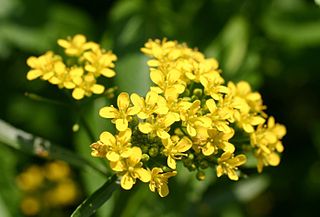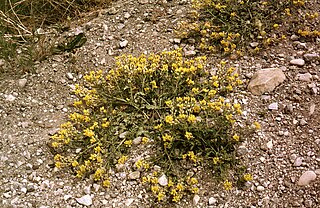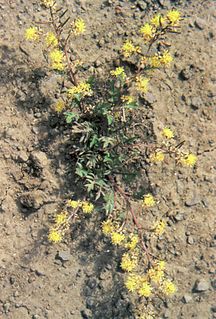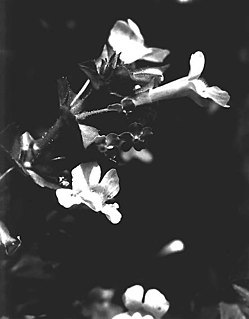
Watercress or yellowcress is a species of aquatic flowering plant in the cabbage family Brassicaceae. Its botanical name is Nasturtium officinale.

Nasturtium is a genus of seven plant species in the family Brassicaceae, best known for the edible watercresses Nasturtium microphyllum and Nasturtium officinale. Nasturtium was previously synonymised with Rorippa, but molecular evidence supports its maintenance as a distinct genus more closely related to Cardamine than to Rorippasensu stricto. Watercress or yellowcress is a common name for plants in this genus.

Rorippa is a flowering plant genus in the family Brassicaceae, native to Europe through central Asia, Africa, and North America. Rorippa species are annual to perennial herbs, usually with yellow flowers and a peppery flavour. They are known commonly as yellowcresses.

Quercus gambelii, with the common name Gambel oak, is a deciduous small tree or large shrub that is widespread in the foothills and lower mountain elevations of western North America. It is also regionally called scrub oak, oak brush, and white oak.

Gambel's quail is a small ground-dwelling bird in the New World quail family. It inhabits the desert regions of Arizona, California, Colorado, New Mexico, Nevada, Utah, Texas, and Sonora; also New Mexico-border Chihuahua and the Colorado River region of Baja California. The Gambel's quail is named in honor of William Gambel, a 19th-century naturalist and explorer of the Southwestern United States.

Tropaeolum majus, the garden nasturtium, nasturtium, Indian cress or monks cress is a species of flowering plant in the family Tropaeolaceae, originating in the Andes from Bolivia north to Colombia. An easily-grown annual with disc-shaped leaves and brilliant orange or red flowers, it is of cultivated, probably hybrid origin. It is not closely related to the genus Nasturtium.

Ceanothus ferrisiae is a rare species of shrub in the family Rhamnaceae. Its common name is coyote ceanothus.
Bloomeria clevelandii is a rare species of flowering plant that is known by the common name San Diego goldenstar. It is native to a strip of scrub and coastal grassland in San Diego County, California, and adjacent Baja California. Genetic analysis of several morphologically similar genera shows that this species, which was named Muilla clevelandii for several decades, is not very closely related to the other members of Muilla and is moved back to Bloomeria.

Rorippa palustris, marsh yellow cress, is a species of flowering plant in the family Brassicaceae. It is widespread and native to parts of Africa, and much of Asia, Europe and Eurasia, North America and the Caribbean. It can also be found in other parts of the world as an introduced species and a common weed, for example, in Australia and South America. It is an adaptable plant which grows in many types of damp, wet, and aquatic habitat. It may be an annual, biennial, or perennial plant, and is variable in appearance as well.

Rorippa austriaca is a species of flowering plant in the family Brassicaceae known by the common names Austrian yellow-cress and Austrian fieldcress. It is native to parts of Europe and Asia, and it is known in North America as an introduced species and sometimes a noxious weed. It can grow in disturbed habitat, such as roadsides, and in very wet habitat such as mudflats. It is a perennial herb growing upright to erect, reaching a maximum height near one meter. The branching stem bears hairless blue-green lance-shaped leaves up to 10 centimeters long. The bases of the upper leaves clasp the stem. The inflorescence is a raceme at the top of the stem and the ends of stem branches. The mustardlike flowers have small yellow petals. The fruit is a plump silique a few millimeters long, but many plants do not fruit and seed production is rare. Reproduction in this species is more often vegetative, the plants concentrating their growth in belowground tissue and spreading clonally. The root system of the plant is particularly aggressive, sending up many new plants as it spreads.

Rorippa columbiae is a species of flowering plant in the family Brassicaceae known by the common names Columbian yellowcress and Columbia yellow cress.

Rorippa curvisiliqua is a species of flowering plant in the family Brassicaceae known by the common name curvepod yellowcress.

Rorippa sinuata is a species of flowering plant in the family Brassicaceae known by the common name spreading yellowcress. It is native to North America, including most all of the western and central United States, where it grows in many types of moist and wet habitat, such as lakeshores and riverbanks, meadows, and mudflats. It is a perennial herb producing spreading stems up to 40 or 50 centimeters long. It is densely hairy, the hairs rounded like sacs or vesicles. The leaves are up to 8 centimeters long and have blades are deeply toothed, lobed, or divided into smaller leaflets. The inflorescence is an elongated raceme occupying the top portion of the stem containing many tiny yellow flowers just a few millimeters long. The fruit is a curved silique which is variable in size and shape but generally contains many minute seeds.

Rorippa subumbellata is a rare species of flowering plant in the family Brassicaceae known by the common names Lake Tahoe yellowcress and Tahoe yellow cress. It is known only from the shores of Lake Tahoe, straddling the border between California and Nevada. There are an estimated fourteen populations of the plant still in existence. It grows only on the direct shoreline of the lake, occupying a seven-foot semi-aquatic zone between the high- and low-tide marks. It is directly impacted by recreational activities on the lake, enduring bombardment by boat wakes, trampling, and construction of docks and other structures.

Sibara filifolia, the Santa Cruz Island winged rockcress or Santa Cruz Island rockcress, is a rare species of flowering plant in the family Brassicaceae. It is endemic to the Channel Islands of California, where it is now known from a few occurrences on San Clemente Island and one population on Catalina Island.
Tetracoccus ilicifolius is a rare species of flowering shrub in the family Picrodendraceae known by the common names hollybush and holly-leaved tetracoccus.

Cirsium vinaceum is a rare species of thistle known by the common name Sacramento Mountains thistle. It is endemic to Otero County, New Mexico, in the United States, where it is known only from the Sacramento Mountains. The plant can be found in six canyon systems in a southern section of this mountain range spanning about 32 kilometers. It is rare because it is limited to a specific type of mountain wetland which is both naturally uncommon and threatened by a number of forces. The plant was federally listed as threatened in 1987.

Erythranthe michiganensis is a rare species of flowering plant in the lopseed family, known by the common name Michigan monkeyflower. This species occurs only in the Grand Traverse and Mackinac Straits areas within the American state of Michigan. It is one of only three plant species that are endemic to Michigan, with the other two being Voss's Goldenrod and Packera insulae-regalis.
Chrysothamnus molestus is a species of flowering plant in the aster family known by the common names Arizona rabbitbrush, Tusayan rabbitbrush, disturbed rabbitbrush, and stickyfruit low rabbitbrush. It is endemic to the State of Arizona in the southwestern United States, where it is known from Coconino, Apache, and Navajo Counties.
Nasturtium floridanum, common names Florida yellowcress and Florida watercress, is an aquatic plant species endemic to Florida, though widely distributed within that state. It is found in wet places at elevations less than 50 m.

















